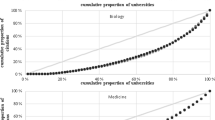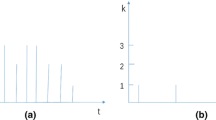Abstract
This paper aims to inform choice of citation time window for research evaluation, by answering three questions: (1) How accurate is it to use citation counts in short time windows to approximate total citations? (2) How does citation ageing vary by research fields, document types, publication months, and total citations? (3) Can field normalization improve the accuracy of using short citation time windows? We investigate the 31-year life time non-self-citation processes of all Thomson Reuters Web of Science journal papers published in 1980. The correlation between non-self-citation counts in each time window and total non-self-citations in all 31 years is calculated, and it is lower for more highly cited papers than less highly cited ones. There are significant differences in citation ageing between different research fields, document types, total citation counts, and publication months. However, the within group differences are more striking; many papers in the slowest ageing field may still age faster than many papers in the fastest ageing field. Furthermore, field normalization cannot improve the accuracy of using short citation time windows. Implications and recommendations for choosing adequate citation time windows are discussed.










Similar content being viewed by others
References
Abbott, A. (2009). Italy introduces performance-related funding. Nature, 460(7255), 559. doi:10.1038/460559a.
Abramo, G., Cicero, T., & D’Angelo, C. A. (2011). Assessing the varying level of impact measurement accuracy as a function of the citation window length. Journal of Informetrics, 5(4), 659–667. doi:10.1016/j.joi.2011.06.004.
Abramo, G., Cicero, T., & D’Angelo, C. A. (2012a). A sensitivity analysis of research institutions’ productivity rankings to the time of citation observation. Journal of Informetrics, 6(2), 298–306. doi:10.1016/j.joi.2011.11.005.
Abramo, G., Cicero, T., & D’Angelo, C. A. (2012b). A sensitivity analysis of researchers’ productivity rankings to the time of citation observation. Journal of Informetrics, 6(2), 192–201. doi:10.1016/j.joi.2011.12.003.
Adams, J. (2005). Early citation counts correlate with accumulated impact. Scientometrics, 63(3), 567–581.
Aksnes, D. W. (2003a). Characteristics of highly cited papers. Research Evaluation, 12(3), 159–170.
Aksnes, D. W. (2003b). A macro study of self-citation. Scientometrics, 56(2), 235–246. doi:10.1023/a:1021919228368.
Aversa, E. S. (1985). Citation patterns of highly cited papers and their relationship to literature aging: A study of the working literature. Scientometrics, 7(3), 383–389.
Costas, R., Van Leeuwen, T. N., & van Raan, A. F. J. (2010). Is scientific literature subject to a ‘Sell By Date’? A general methodology to analyze the ‘durability’of scientific documents. Journal of the American Society for Information Science and Technology, 61(2), 329–339.
Costas, R., van Leeuwen, T. N., & van Raan, A. F. J. (2011). The “Mendel syndrome” in science: durability of scientific literature and its effects on bibliometric analysis of individual scientists. Scientometrics, 89(1), 177–205.
De Bellis, N. (2009). Bibliometrics and citation analysis: from the Science citation index to cybermetrics. Lanham, MD: Scarecrow Press.
Garfield, E. (1980). Premature discovery or delayed recognition—why. Current Contents, 21, 5–10.
Garfield, E. (1985a). The articles most cited in the SCI from 1961 to 1982. 7. Another 100 citation-classics—the Watson-Crick double helix has its turn. Current Contents, 20, 3–12.
Garfield, E. (1985b). The articles most cited in the SCI from 1961 to 1982. 8. Ninety-eight more classic papers from unimolecular reaction velocities to natural opiates-the changing frontiers of science. Current Contents, 33, 3–11.
Garfield, E. (1986). Letter to editor. Information Processing and Management, 22(5), 445.
Glänzel, W. (2008). Seven myths in bibliometrics. About facts and fiction in quantitative science studies. In H. Kretschmer & F. Havemann (Eds.), Proceedings of WIS 2008 (pp. 1–10). Germany: Berlin.
Glänzel, W., Debackere, K., Thijs, B., & Schubert, A. (2006). A concise review on the role of author self-citations in information science, bibliometrics and science policy. Scientometrics, 67(2), 263–277. doi:10.1007/s11192-006-0098-9.
Glänzel, W., Schlemmer, B., & Thijs, B. (2003). Better late than never? On the chance to become highly cited only beyond the standard bibliometric time horizon. Scientometrics, 58(3), 571–586.
Glänzel, W., & Schoepflin, U. (1995). A bibliometric study on ageing and reception processes of scientific literature. Journal of information Science, 21(1), 37–53.
King, D. A. (2004). The scientific impact of nations. Nature, 430(6997), 311–316. doi:10.1038/430311a.
Levitt, J. M., & Thelwall, M. (2008). Patterns of annual citation of highly cited articles and the prediction of their citation ranking: A comparison across subjects. Scientometrics, 77(1), 41–60.
Leydesdorff, L. (2008). Caveats for the use of citation indicators in research and journal evaluations. Journal of the American Society for Information Science and Technology, 59(2), 278–287. doi:10.1002/Asi.20743.
Leydesdorff, L. (2009). How are new citation-based journal indicators adding to the bibliometric toolbox? Journal of the American Society for Information Science and Technology, 60(7), 1327–1336. doi:10.1002/asi.21024.
Leydesdorff, L., & Opthof, T. (2010). Normalization at the field level: Fractional counting of citations. Journal of Informetrics, 4(4), 644–646. doi:10.1016/j.joi.2010.05.003.
Line, M. B. (1993). Changes in the use of literature with time: Obsolescence revisited. Library Trends, 41(4), 665–683.
Moed, H. F., Burger, W., Frankfort, J., & van Raan, A. (1985). The application of bibliometric indicators: Important field- and time-dependent factors to be considered. Scientometrics, 8(3), 177–203. doi:10.1007/bf02016935.
Moed, H. F., van Leeuwen, T. N., & Reedijk, J. (1998). A new classification system to describe the ageing of scientific journals and their impact factors. Journal of Documentation, 54(4), 387–419.
Porter, A. L. (1977). Citation analysis: Queries and caveats. Social Studies of Science, 7(2), 257–267. doi:10.1177/030631277700700207.
Radicchi, F., & Castellano, C. (2011). Rescaling citations of publications in physics. Physical Review E, 83(4), 046116.
Radicchi, F., Fortunato, S., & Castellano, C. (2008). Universality of citation distributions: Toward an objective measure of scientific impact. Proceedings of the National academy of Sciences of the United States of America, 105(45), 17268–17272. doi:10.1073/pnas.0806977105.
Rogers, J. D. (2010). Citation analysis of nanotechnology at the field level: Implications of RD evaluation. Research Evaluation, 19(4), 281–290.
Schubert, A., & Braun, T. (1996). Cross-field normalization of scientometric indicators. Scientometrics, 36(3), 311–324. doi:10.1007/bf02129597.
Stent, G. (1972). Prematurity and uniqueness in scientific discovery. Scientific American, 227(6), 84–93.
Van Raan, A. F. J. (2004). Sleeping beauties in science. Scientometrics, 59(3), 467–472.
Walters, G. D. (2011). The citation life cycle of articles published in 13 American Psychological Association journals: A 25-year longitudinal analysis. Journal of the American Society for Information Science and Technology, 62(8), 1629–1636. doi:10.1002/asi.21560.
Acknowledgments
The author would like to thank Stefan Hornbostel, Sybille Hinze, and William Dinkel for their efforts in the early stage of project initiation and research design, Diana Hicks and Daniel Sirtes for their suggestions which were most helpful in improving the paper, Jasmin Schmitz, Haiko Lietz, Marion Schmidt, Pei-Shan Chi, and Jana Schütze for their many helpful ideas and collegial support, and two anonymous reviewers for their critical and constructive comments. The research underlying this paper was supported by the German Federal Ministry for Education and Research (BMBF, project number 01PQ08004A). The data used in this paper are from a bibliometrics database developed and maintained by the Competence Center for Bibliometrics for the German Science System (KB) and derived from the 1980 to 2011 Science Citation Index Expanded (SCIE), Social Sciences Citation Index (SSCI), and Arts and Humanities Citation Index (AHCI) prepared by Thomson Reuters (Scientific) Inc. (TR®), Philadelphia, Pennsylvania, USA: ©Copyright Thomson Reuters (Scientific) 2012. The author thanks the KB team for its collective effort in the development of the KB database.
Author information
Authors and Affiliations
Corresponding author
Rights and permissions
About this article
Cite this article
Wang, J. Citation time window choice for research impact evaluation. Scientometrics 94, 851–872 (2013). https://doi.org/10.1007/s11192-012-0775-9
Received:
Published:
Issue Date:
DOI: https://doi.org/10.1007/s11192-012-0775-9




